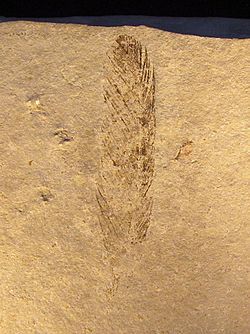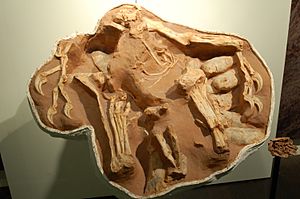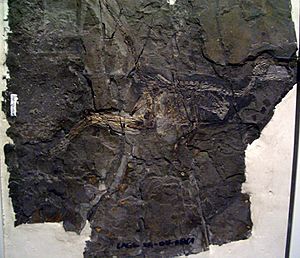Feathered dinosaur facts for kids
A feathered dinosaur is a dinosaur with feathers. It is now thought that all coelurosaurs, and perhaps all theropods, had feathers.
The possibility that dinosaurs are closely related to birds raised the possibility of feathers. Fossils of Archaeopteryx include well-preserved feathers, but it was not until the early 1990s that clearly non-bird dinosaur fossils were discovered with preserved feathers. About 40 genera of theropods are now known to be feathered.
Most of these fossils come from the Yixian formation in China. The fossil feathers of one specimen, Shuvuuia deserti, have been tested positive for beta-keratin in immunological tests. This is the main protein in bird feathers.
Contents
Fossil evidence
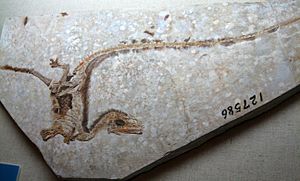
After a century without clear evidence, well-preserved fossils of feathered dinosaurs were discovered during the 1990s, and more continue to be found. The fossils were preserved in a Lagerstätte — a sedimentary deposit exhibiting remarkable richness and completeness in its fossils — in Liaoning, China.
The area had repeatedly been smothered in volcanic ash by eruptions in Inner Mongolia 124 million years ago, during the Lower Cretaceous. The fine-grained ash preserved the living organisms that it buried in fine detail. The area was teeming with life, with millions of leaves, angiosperms (the oldest known), insects, fish, frogs, salamanders, mammals, turtles, lizards and crocodilians discovered to date.
The most important discoveries at Liaoning have been a host of feathered dinosaur fossils, with a steady stream of new finds filling in the picture of the dinosaur-bird connection and adding more to theories of the evolutionary development of feathers and flight. Quill knobs were found an ulna of Velociraptor mongoliensis. These are associated with large, well-developed secondary feathers.
Behavioural evidence, in the form of an oviraptorosaur on its nest, showed another link with birds. Its forearms were folded, like those of a bird. Although no feathers were preserved, it is likely that these would have been present to keep eggs and juveniles warm.
Evidence in amber
The feathered tail of a non-avialan (non-bird) theropod has been found preserved in mid-Cretaceous (∼99 mya) amber from Kachin State, Myanmar (Burma). The BBC describe it as "perfectly preserved". Lida Xing found it at an amber market in Myitkina, Myanmar. The amber was already polished for jewellery: the seller thought it was plant material. However, it was the tail of a feathered dinosaur about the size of a sparrow. The feathers were not flight feathers. Dr Paul Barrett, from London's Natural History Museum, called the specimen a "beautiful fossil", describing it as a "really rare occurrence of vertebrate material in amber".
Cretaceous period
In 2011, samples of amber were discovered to contain preserved feathers from the Cretaceous period, with evidence that they were from both dinosaurs and birds. Initial analysis suggests that some of the feathers were used for insulation, and not flight.
Current knowledge
List of dinosaurs with evidence of feathers
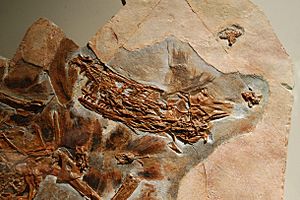
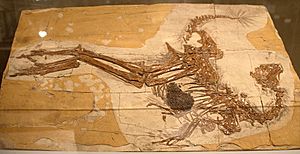

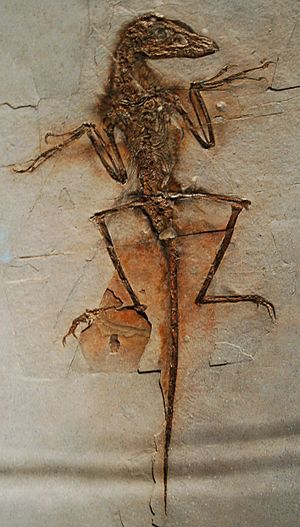
A number of non-avialan dinosaurs are now known to have been feathered. Direct evidence of feathers exists for the following genera, listed in the order currently accepted evidence was first published.
The evidence consists of feather impressions, or convincing skeletal or chemical evidence. Skeletal evidence would be the presence of quill knobs (the anchor points for wing feathers on the forelimb) or a pygostyle (the fused vertebrae at the tail tip which often supports large feathers).
For comparison: Archaeopteryx (1861; avialan) definitely had working flight feathers with off-centre rachis (stem). Otherwise, apart from the front limbs, it was a typical small carnivorous dinosaur.
- Avimimus portentosus (inferred 1987: quill knobs)
- Sinosauropteryx prima (1996)
- Protarchaeopteryx robusta (1997)
- GMV 2124 (1997).
- Caudipteryx zoui (1998)
- Shuvuuia deserti (1999)
- Sinornithosaurus millenii (1999)
- Beipiaosaurus inexpectus (1999)
- Caudipteryx dongi (2000)
- Caudipteryx sp. (2000)
- Microraptor zhaoianus (2000)
- Nomingia gobiensis (inferred 2000: pygostyle)
- Psittacosaurus sp.? (2002)
- Scansoriopteryx heilmanni (2002)
- Yixianosaurus longimanus (2003)
- Dilong paradoxus (2004)
- Jinfengopteryx elegans (2005)
- Juravenator starki (2006)
- Sinocalliopteryx gigas (2007)
- Velociraptor mongoliensis (inferred 2007: quill knobs)
- Epidexipteryx hui (2008)
- Similicaudipteryx yixianensis (inferred 2008: pygostyle; confirmed 2010)
- Zhongornis haoae (2008)
- Tianyulong confuciusi? (2009)
- Concavenator corcovatus? (inferred 2010: quill knobs?)
- Yutyrannus huali (2012)
- Microraptor hanqingi (2012)
- Ornithomimus edmontonicus (2012)
- Ningyuansaurus wangi (2012)
- Eosinopteryxbrevipenna (2013)
- Citipati osmolskae (inferred 2013: pygostyle)
- Conchoraptor gracilis (inferred 2013: pygostyle)
- Jianchangosaurus yixianensis (2013)
- Aurornis xui (2013; possibly avialan)
- Changyuraptor yangi (2014)
- Kulindadromeus zabaikalicus? (2014)
- Citipati osmolskae (inferred 2014: pygostyle)
- Conchoraptor gracilis (inferred 2014: pygostyle)
- Deinocheirus mirificus (inferred 2014: pygostyle)
- Yi qi (2015)
- Note, filamentous structures in some ornithischian dinosaurs (Psittacosaurus, Tianyulong) and pterosaurs may or may not be homologous with the feathers and protofeathers of theropods.
Related pages
Images for kids
-
The Berlin Archaeopteryx
-
Cast in Japan of a resting trace from Massachusetts, which was argued to have been made by a theropod like Dilophosaurus and to include feather impressions around the belly (arrow), but this has been questioned
See also
 In Spanish: Dinosaurios con plumas para niños
In Spanish: Dinosaurios con plumas para niños


